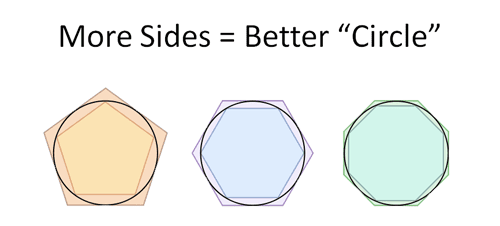 |
| source |
Today is a day to celebrate for math enthusiasts and pie
lovers everywhere. Each year, March 14 marks a special date around the world
because its numerical form is 3/14, and 3.14 is the most used form of the
numerical constant, pi (π). And
although it is commemorating a mathematical value, it is usually celebrated
with delicious pies.
Pi Day is thought to have started in 1988, but the U.S.
House of Representatives voted to make March 14 National Pi Day in 2009.
Coincidentally, Pi Day also falls on Albert Einstein’s birthday, all the more
reason to celebrate the world of science today.
 |
| source |
The significance of Pi
Pi is arguably the most important number in math and science. It is the ratio of the circumference of a circle to its diameter. If you measured the diameter of a circle, it would take approximately 3.14159 diameters to wrap around the same circle. The gif below shows this concept.
Pi, usually represented by the symbol π, is an irrational number, meaning that it
cannot be expressed as a fraction. It is an infinite number and does not repeat
the way that some fractions do. For example, 1/3 equals 0.3333… with the 3
repeating infinitely. Pi’s digits are not in any pattern, so they cannot be
predicted because of their randomness.
 |
| source |
Pi is used mainly for geometric calculations like computing
values related to spheres, circles, and ellipses. However, it is also useful in
many mathematical equations in science like thermodynamics, cosmology,
electromagnetism, and mechanics. This is because many aspects of physical and
chemical systems are represented with components of spheres and points. Shapes
of data sets can also frequently be represented graphically by components of
circles, so pi is important for statistics and data analysis.
History of Pi
The earliest known approximations to 1% of pi date all the
way back to 1900 BC, found in Egypt and Babylon. These approximations were
found in clay tablets stating that the area of a circle can be approximated
with the value (16/9)2 ≈ 3.16 treated as pi. There is also
speculation that the Great Pyramid of Giza incorporated pi into its dimensions.
The ratio of the perimeter to the height of the pyramid can be approximated by
2π. While some think this is evidence
of knowledge of the number pi, many think that it is based on other factors.
The value of pi has been sought after since its significance
in describing circles was discovered. The Greek mathematician Archimedes
devised the first known algorithm to calculate it using circumscribed and
inscribed polygons, shown in the picture below. He did this using the ratio of
the perimeter of a polygon to its width. The more sides the polygon has, the
more circular it is, and the closer the value is to pi. Using this method,
Archimedes approximated pi to 3.1415 or 22/7 in 250 BC. The most digits of pi found
using this method was 38 in 1630.
 |
| source |
The infinite series method revolutionized the calculation of
pi in the 1600s. Basically, it adds the terms of an infinite sequence of
numbers. Using this method, pi can be determined with greater precision than
the polygon approximation. It was first discovered in about 1400 in India, but
was not originally used to calculate pi.
Beginning in the computer era, pi can be calculated using
infinite series to many digits with iterative algorithms. As computer memory
keeps expanding, so does our knowledge of the value of pi.
Why do we care what
the billionth digit of pi is?
For many calculations using pi, only knowing several digits
is useful. However, knowing pi to many digits is advantageous for many reasons.
There are many benefits for testing computational systems. Calculating digits
of pi is useful to test supercomputers and algorithms. It also provides data to
calculate math concepts because of its randomness.
Pi is an incredibly important number in science, math, and
engineering. So let’s celebrate it with style today. As Pi day falls on a
Friday this year, I would like to refer to today as Friday Pi Day, which calls
for a cheers, and birthday celebration for Einstein.
 |
| source |
Thanks for reading, and cheers to your brain!
Like my Facebook page to stay up to date on weekly blog posts and other science findings!

No comments:
Post a Comment